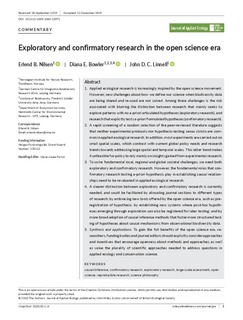| dc.contributor.author | Nilsen, Erlend Birkeland | |
| dc.contributor.author | Bowler, Diana Elizabeth | |
| dc.contributor.author | Linnell, John Durrus | |
| dc.date.accessioned | 2020-02-10T11:33:31Z | |
| dc.date.available | 2020-02-10T11:33:31Z | |
| dc.date.issued | 2002 | |
| dc.identifier.issn | 0021-8901 | |
| dc.identifier.uri | http://hdl.handle.net/11250/2640662 | |
| dc.description.abstract | 1. Applied ecological research is increasingly inspired by the open science movement. However, new challenges about how we define our science when biodiversity data are being shared and reused are not solved. Among these challenges is the risk associated with blurring the distinction between research that mainly seeks to explore patterns with no a-priori articulated hypotheses (exploratory research), and research that explicitly tests a-priori formulated hypotheses (confirmatory research).2. A rapid screening of a random selection of the peer-reviewed literature suggests that neither experimental protocols nor hypothesis-testing sensu stricto are common in applied ecological research. In addition, most experiments are carried out on small spatial scales, which contrast with current global policy needs and research trends towards addressing large spatial and temporal scales. This latter trend makes it unfeasible for policy to rely mainly on insights gained from experimental research.3. To solve fundamental local, regional and global societal challenges, we need both exploratory and confirmatory research. However, the fundamental roles that con-firmatory research testing a priori hypothesis play in establishing causal relationships need to be revaluated in applied ecological research.4. A clearer distinction between exploratory and confirmatory research is currently needed, and could be facilitated by allocating journal sections to different types of research; by embracing new tools offered by the open science era, such as pre- registration of hypothesis; by establishing new systems where post-hoc hypotheses emerging through exploration can also be registered for later testing; and by more broad adoption of causal inference methods that foster more structured test-ing of hypotheses about causal mechanisms from observational biodiversity data.5. Synthesis and applications. To gain the full benefits of the open science era, re-searchers, funding bodies and journal editors should explicitly consider approaches and incentives that encourage openness about methods and approaches, as well as value the plurality of scientific approaches needed to address questions in applied ecology and conservation science | nb_NO |
| dc.language.iso | eng | nb_NO |
| dc.rights | Navngivelse 4.0 Internasjonal | * |
| dc.rights.uri | http://creativecommons.org/licenses/by/4.0/deed.no | * |
| dc.subject | causal inference | nb_NO |
| dc.subject | confirmatory research | nb_NO |
| dc.subject | exploratory research | nb_NO |
| dc.subject | large-scale assessment | nb_NO |
| dc.subject | open science | nb_NO |
| dc.subject | reproducible research | nb_NO |
| dc.subject | science philosophy | nb_NO |
| dc.title | Exploratory and confirmatory research in the open science era | nb_NO |
| dc.type | Peer reviewed | nb_NO |
| dc.type | Journal article | |
| dc.description.version | publishedVersion | nb_NO |
| dc.rights.holder | © 2020 The Authors | nb_NO |
| dc.subject.nsi | VDP::Matematikk og Naturvitenskap: 400::Zoologiske og botaniske fag: 480 | nb_NO |
| dc.source.journal | Journal of Applied Ecology | nb_NO |
| dc.identifier.doi | 10.1111/1365-2664.13571 | |
| dc.identifier.cristin | 1792578 | |
| dc.relation.project | Norges Forskningsråd: 251112 | nb_NO |

